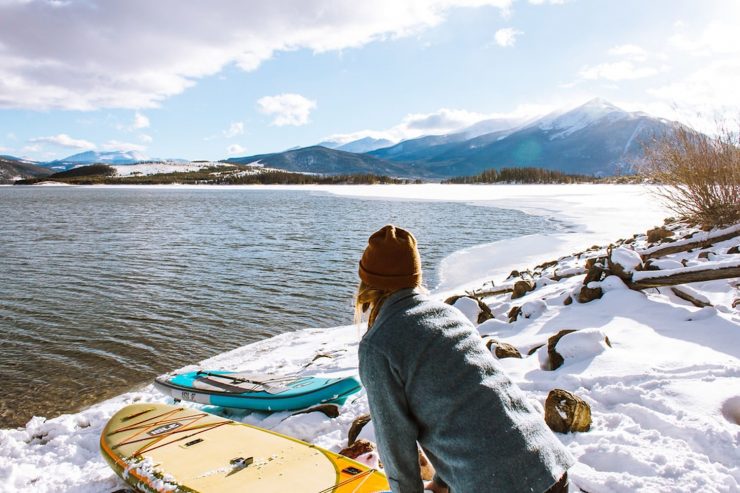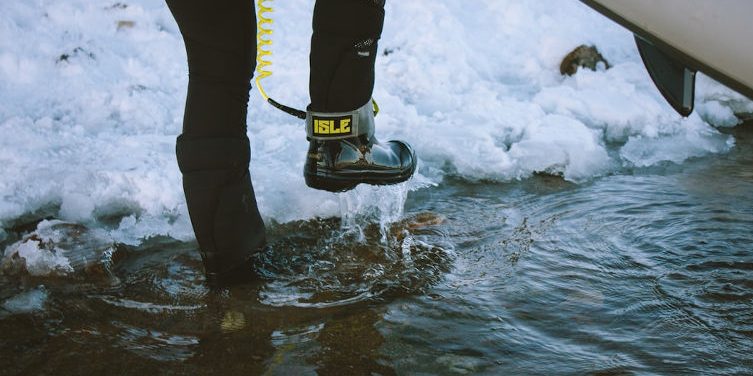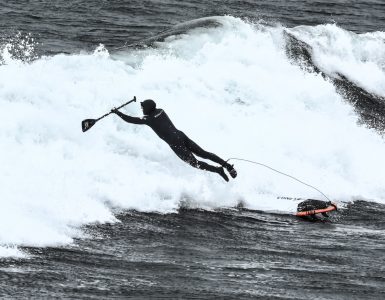Stand-up paddling is a summer activity for most people, but it doesn’t have to be. Because with the right SUP clothing, you can paddle on the water all year round.
What SUP clothing do I need?
Find out what SUP clothing is needed in which season and why you should definitely choose special SUP clothing in winter.
SUP clothing according to season:
Content
- 1 What SUP clothing do I wear in which season?
- 2 Overview: What SUP clothing is available?
- 3 Conclusion: Which SUP clothing is essential?
- 4 FAQ: Frequently asked questions about SUP clothing
- 4.1 What clothing should I wear for SUP?
- 4.2 Which wetsuit for SUP riding?
- 4.3 Which dry suit for SUP riding?
- 4.4 Which lifejacket for SUP riding?
- 4.5 Which shoes for SUP riding?
- 4.6 What clothes to wear for SUP?
- 4.7 Which wetsuit for SUP riding?
- 4.8 Which swim vest for stand-up paddling?
- 4.9 Where to buy SUP clothing?
- 4.10 Are there also drysuits for children with SUP clothing?
- 4.11 What are the prices for SUP clothing?
- 4.12 Which well-known SUP clothing brands are there?
What SUP clothing do I wear in which season?
Depending on the weather and weather conditions, different clothing is required for stand-up paddling. We have researched which clothing is needed when.
SUP clothing in summer
What do I wear?
- Boardshorts or bikini
- Hat or cap
- Rashguard or T-shirt
- Paddle board life jacket
- SUP shoes (optional)
- Wetsuit or springsuit/shorty (in case of rain/cold)
Summer is by far the most popular time for stand-up paddlers. Lots of sunshine and high temperatures mean that only a minimum of SUP clothing is needed when paddling.
If you are only on the water for a short time, you can often get by with a swimming costume/bikini. A rashguard with a UV protection factor, or at least a T-shirt, should be worn on short tours. If you are out and about for a long time, you should wear a long-sleeved rashguard to provide the best possible protection from the sun. It is best to always apply sunscreen.
For safety, a swim vest should always be worn on the water, especially for children. You should also bear in mind that the SUP board may have to be carried for sections of the tour. SUP shoes are useful for this. Thin SUP shoes made of neoprene, water shoes or sandals are best suited.
A 3/2 wetsuit or a springsuit/shorty with short arms and legs is suitable for cold and rainy summer days.
SUP clothing in winter
What do I wear?
- SUP Surfing: Wetsuit
- SUP Touring: SUP dry suit or wetsuit
- Neoprene gloves
- Neoprene booties
- Neoprene hood
- Cap
If you want to live out your SUP passion even in winter, you shouldn’t be put off by the low temperatures. With the right clothing, paddling in winter is no problem.
SUP surfing in winter:
If you want to hit the waves in the cold season, you need the right wetsuit. How thick this needs to be depends on the water temperature.
Read more about wetsuits here: Wetsuit guide.
| Water temperature | Thickness | |
|---|---|---|
| below 9 °C | 6/5 mm | |
| 10 °C-15 °C | 5/4 mm 4/3 mm | |
| 13 °C-18 °C | 4/3 mm 3/2 mm | |
| 15 °C-20 °C | 3/2 mm | |
| The colder the water, the thicker the wetsuit needs to be. | ||
If the water is very cold, or for people who are more sensitive to the cold, it makes sense to wear neoprene gloves, booties and/or a hood. This keeps the body even warmer and allows you to stay in the water longer.
SUP touring in winter:
A wetsuit can also be worn for SUP touring, but the better choice is a dry suit. Why? Unlike the neo, the drysuit does not allow water to penetrate and keeps you warmer in the air.
Why is this so important?
Falling into ice-cold water can lead to a cold shock, which in the worst case can result in drowning. As the drysuit is fitted with waterproof cuffs at the openings, no cold water can reach the body. This prevents cold shock and makes it easy to get back on the board and continue paddling.
This video from SUP TV shows why cold shock is dangerous:
What do I wear under the drysuit?
It is best to wear two additional layers under the dry suit. We recommend thermal underwear directly on the body and warm functional clothing, for example fleece, on top.
On the internet, you can always find sites that claim that you can simply paddle with warm clothing and a waterproof jacket in winter. This is not true, because on the one hand there is a risk of drowning due to cold shock. On the other hand, you have to paddle back to shore in your wet clothes.
The constant cooling caused by the ambient air, wind and water means there is a risk of hypothermia, which in the worst case can lead to death.
SUP clothing in spring and fall
Choosing the right SUP clothing can be a little difficult here, as temperatures can fluctuate considerably. However, every water sports enthusiast should dress appropriately for the water temperature, not the air temperature.
A wetsuit is needed for SUP surfing. This table shows which thickness is suitable for which water temperature.
The same applies to SUP tours as in winter, although less warm clothing is needed here to avoid sweating so quickly in higher air temperatures.
Overview: What SUP clothing is available?
This clothing is ideal for stand-up paddling:
- Wetsuit: Best suited for SUP surfing because it reliably keeps the body warm in the water. The colder the water, the thicker the wetsuit needs to be. If you don’t want to get wet anyway, it’s better to choose a dry suit.
- Dry suit: In contrast to the wetsuit, the dry suit does not let any water inside. This protects the body from a cold shock. In addition, a dry suit keeps you warmer in the air than a wetsuit.
- Rashguard: T-shirt made of nylon and/or Lycra to protect the body from UV radiation. The material of rashguards dries quickly and feels pleasant on the skin even when wet.
- Headwear: A hat or cap is a must, especially in summer. In winter, we recommend a thick hat to prevent your head from cooling down.
- SUP shoes: Water shoes, sandals or thin neoprene booties are suitable as SUP shoes.
- Neoprene booties: Neoprene booties that keep your feet warm. The colder the water, the thicker the neoprene of the booties needs to be. Neoprene socks can also be worn
- Neoprene gloves: Neoprene gloves keep your hands warm for longer. Here too, the colder the water, the thicker the neoprene should be.
- Neoprene hood: Highly recommended for SUP surfing at low temperatures to keep your head warm. The thicker the neoprene, the better the hood will keep your head warm.
- Neoprene socks: Neoprene socks are both waterproof and heat-insulating, making them a good alternative to SUP shoes.
- Swim vest: A swim vest makes stand-up paddling a lot safer, which is why children in particular, but also adults, should not do without one.
- Functional clothing:hermo underwear and warm functional clothing form the two layers under the drysuit. ATTENTION: You should never paddle in cold water wearing only functional clothing.
- Sunscreen: Although it is not part of your clothing, sunscreen is a must in summer.
Conclusion: Which SUP clothing is essential?
With the right SUP clothing, you can paddle all year round, no matter how low the temperatures drop. However, you should always make sure you wear suitable clothing, otherwise there is a high risk of hypothermia, especially in winter.


















Add comment